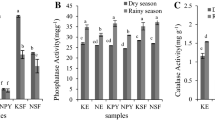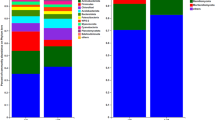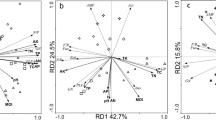Abstract
Purpose
Soil microbes play a critical role in the recycling of soil nutrients and soil fertility. Different crop types greatly influence the soil environment, including the carbon and nitrogen biogeochemical cycles, and the effects may be particularly important on the terraces of the Loess Plateau. In this study, the characteristics of soil physicochemical properties and microbial activity were investigated under different crop types to establish relationships among soil microbial biomass, enzyme activities, and physicochemical properties.
Materials and methods
Soils under four typical crops (potato, corn, apple, and intercropping (apple and potatoes)) grown on terraces constructed during a similar period were examined at an experimental site on the Loess Plateau, with 5-year abandoned land as the control. The activities of soil invertase, urease, and alkaline phosphatase, soil microbial biomass carbon (MBC), soil microbial biomass nitrogen (MBN), and the ratio MBC/MBN, and their relationships with soil physicochemical properties were investigated using redundancy analysis and partial redundancy analysis.
Results and discussion
(1) For soil physicochemical properties, including organic carbon, total nitrogen, total phosphorus, nitrate nitrogen, and available phosphorus, the lowest concentrations were in abandoned land and the highest contents were under apple and intercropping; (2) the activities of soil invertase were in the order intercropping > corn > apple > potato > abandoned land, whereas the activities of soil urease in apple and intercropping were more than twofold higher than those in abandoned land; (3) soil microbial biomass carbon and the ratio of MBC/MBN were highest in abandoned land, which indicated that abandoned land had a high proportion of bacterial to fungal biomass; (4) soil microbial activity was affected by the application of organic manure under terrace crop systems.
Conclusions
The contents of soil organic carbon (SOC), total nitrogen (TN), total phosphorus (TP), and available phosphorus (AP) in abandoned land were significantly lower than those under all crop types; thus, directly abandoned farmland was not favorable for soil microbial activity in the typical loess hilly-gully region. Soil TP, moisture (MS), and NO3−–N were identified as the key factors affecting soil microbial activity in the 0–20-cm soil layer, and soil TP, AP, NH4+–N, and NO3−–N were the significant factors in the 20–40-cm layer.




Similar content being viewed by others
References
Ajwa HA, Dell CJ, Rice CW (1999) Changes in enzyme activities and microbial biomass of tallgrass prairie soil as related to burning and nitrogen fertilization. Soil Biol Biochem 31:769–777
Altieri MA (1999) The ecological role of biodiversity in agroecosystems. Agric Ecosyst Environ 74:19–31
Bainard L, Koch A, Gordon A, Klironomos J (2013) Growth response of crops to soil microbial communities from conventional monocropping and tree-based intercropping systems. Plant Soil 363:345–356
Berg G (2009) Plant–microbe interactions promoting plant growth and health: perspectives for controlled use of microorganisms in agriculture. Appl Microbiol Biotechnol 84:11–18
Bucher AE, Lanyon LE (2005) Evaluating soil management with microbial community-level physiological profiles. Appl Soil Ecol 29:59–71
Chaudhry V, Rehman A, Mishra A, Chauhan PS, Nautiyal CS (2012) Changes in bacterial community structure of agricultural land due to long-term organic and chemical amendments. Microb Ecol 64:450–460
Chu H, Fierer N, Lauber CL, Caporaso J, Knight R, Grogan P (2010) Soil bacterial diversity in the Arctic is not fundamentally different from that found in other biomes. Environ Microbiol 12:2998–3006
Cleveland CC, Liptzin D (2007) C: N: P stoichiometry in soil: is there a “Redfield ratio” for the microbial biomass? Biogeochemistry 85:235–252
Cui B, Zhao H, Li X, Zhang K, Ren H, Bai J (2010) Temporal and spatial distributions of soil nutrients in Hani terraced paddy fields, Southwestern China. Procedia Environ Sci 2:1032–1042
Fauci MF, Dick RP (1994) Soil microbial dynamics: short- and long-term effects of inorganic and organic nitrogen. Soil Sci Soc Am J 58(3):801–806
Guan SY (1986) Soil enzyme and its study method. China Agriculture Press (in Chinese)
Hou J, Fu B, Liu Y, Lu N, Gao G, Zhou J (2014) Ecological and hydrological response of farmlands abandoned for different lengths of time: evidence from the loess hill slope of China. Glob Planet Chang 113:59–67
Ilstedt U, Singh S (2005) Nitrogen and phosphorus limitations of microbial respiration in a tropical phosphorus-fixing acrisol (ultisol) compared with organic compost. Soil Biol Biochem 37:1407–1410
Jenkinson DS (1976) The effects of biocidal treatments on metabolism in soil—IV. The decomposition of fumigated organisms in soil. Soil Biol Biochem 8:203–208
Jenkinson DS, Brookes PC, Powlson DS (2004) Measuring soil microbial biomass. Soil Biol Biochem 36:5–7
Jia GM, Cao J, Wang C, Wang G (2005) Microbial biomass and nutrients in soil at the different stages of secondary forest succession in Ziwulin, northwest China. For Ecol Manag 217:117–125
Joergensen RG, Anderson TH, Wolters V (1995) Carbon and nitrogen relationships in the microbial biomass of soils in beech (Fagus sylvatica L.) forests. Biol Fertil Soils 19:141–147
Kagabo D, Stroosnijder L, Visser S, Moore D (2013) Soil erosion, soil fertility and crop yield on slow-forming terraces in the highlands of Buberuka, Rwanda. Soil Tillage Res 128:23–29
Kalembasa SJ, Jenkinson DS (1973) A comparative study of titrimetric and gravimetric methods for the determination of organic carbon in soil. J Sci Food Agric 24:1085–1090
Lange M, Eisenhauer N, Sierra C, Bessler H, Engels C, Griffiths R, Mellado-Vázquez P, Malik A, Roy J, Scheu S (2015) Plant diversity drives soil carbon storage by increased soil microbial activity. Nat Commun 6:6707
Li Q, Liang JH, He YY, Hu QJ, Yu S (2014) Effect of land use on soil enzyme activities at karst area in Nanchuan, Chongqing, Southwest China. Plant Soil Environ 60:15–20
Liu C-A, Li F-R, Zhou L-M, Zhang R-H, Lin S-L, Wang L-J, Siddique KH, Li F-M (2013) Effect of organic manure and fertilizer on soil water and crop yields in newly-built terraces with loess soils in a semi-arid environment. Agric Water Manag 117:123–132
Lundquist EJ, Jackson LE, Scow KM, Hsu C (1999) Changes in microbial biomass and community composition, and soil carbon and nitrogen pools after incorporation of rye into three California agricultural soils. Soil Biol Biochem 31:221–236
Moghimian N, Hosseini SM, Kooch Y, Darki BZ (2017) Impacts of changes in land use/cover on soil microbial and enzyme activities. Catena 157:407–414
O’Connell D (1975) The measurement of apparent specific gravity of soils and its relationship to mechanical composition and plant root growth. Technical Bulletin, Ministry of Agriculture, Fisheries and Food
Oh YM, Kim M, Lee-Cruz L, Lai-Hoe A, Go R, Ainuddin N, Rahim RA, Shukor N, Adams JM (2012) Distinctive bacterial communities in the rhizoplane of four tropical tree species. Microb Ecol 64:1018–1027
Olsen S, Sommers L, Page A (1982) Methods of soil analysis. Part 2. Chemical and microbiological properties of phosphorus. ASA Monograph 9:403–430
Onishi T, Nakamura K, Horino H, Adachi T, Mitsuno T (2012) Evaluation of the denitrification rate of terraced paddy fields. J Hydrol 436:111–119
Pietsch D, Mabit L (2012) Terrace soils in the Yemen Highlands: using physical, chemical and radiometric data to assess their suitability for agriculture and their vulnerability to degradation. Geoderma 185:48–60
Portenga EW, Bierman PR (2011) Understanding Earth’s eroding surface with 10 Be. GSA Today 21:4–10
Poulsen PH, Al-Soud WA, Bergmark L, Magid J, Hansen LH, Sørensen SJ (2013) Effects of fertilization with urban and agricultural organic wastes in a field trial—prokaryotic diversity investigated by pyrosequencing. Soil Biol Biochem 57:784–793
Powlson DS, Prookes PC, Christensen BT (1987) Measurement of soil microbial biomass provides an early indication of changes in total soil organic matter due to straw incorporation. Soil Biol Biochem 19:159–164
Ramirez KS, Lauber CL, Knight R, Bradford MA, Fierer N (2010) Consistent effects of nitrogen fertilization on soil bacterial communities in contrasting systems. Ecology 91:3463–3470
Ramirez KS, Craine JM, Fierer N (2012) Consistent effects of nitrogen amendments on soil microbial communities and processes across biomes. Glob Chang Biol 18:1918–1927
Rej B, Brinkman JA, Smith A (2005) Seasonal variations in enzyme activity and organic carbon in soil of a burned and unburned hardwood forest. Soil Biol Biochem 37:1419–1426
Shen C, Xiong J, Zhang H, Feng Y, Lin X, Li X, Liang W, Chu H (2013) Soil pH drives the spatial distribution of bacterial communities along elevation on Changbai Mountain. Soil Biol Biochem 57:204–211
Song YN, Zhang FS, Marschner P, Fan FL, Gao HM, Bao XG, Li L (2007) Effect of intercropping on crop yield and chemical and microbiological properties in rhizosphere of wheat (Triticum aestivum L.), maize (Zea mays L.), and faba bean (Vicia faba L.) Biol Fertil Soil 43(5):565–574
Sparks D, Bartels J (1996) Chemical methods. Part 3. In: SSAA Book Series 5.3, Soil Science Society of America, Inc. American Society of Agronomy, Inc. Madison, Wisconsin, USA
Sparling G, West A (1988) Modifications to the flmigation-extraction technique to permit simultaneous extraction and estimation of soil microbial c and n. Commun Soil Sci Plant Anal 19:327–344
Staff SS (1999) Soil taxonomy: a basic system of soil classification for making and interpreting soil surveys. USDA Soil Conservation Service, Washington
Sun R, Zhang X-X, Guo X, Wang D, Chu H (2015) Bacterial diversity in soils subjected to long-term chemical fertilization can be more stably maintained with the addition of livestock manure than wheat straw. Soil Biol Biochem 88:9–18
Thomson BC, Tisserant E, Plassart P, Uroz S, Griffiths RI, Hannula SE, Buée M, Mougel C, Ranjard L, Van Veen JA (2015) Soil conditions and land use intensification effects on soil microbial communities across a range of European field sites. Soil Biol Biochem 88:403–413
Tonon G, Boldreghini P, Gioacchini P (2005) Seasonal changes in microbial nitrogen in an old broadleaf forest and in a neighbouring young plantation. Biol Fertil Soil 41:101–108
Vance E, Brookes P, Jenkinson D (1987) An extraction method for measuring soil microbial biomass C. Soil Biol Biochem 19:703–707
Wakelin SA, Colloff MJ, Harvey PR, Marschner P, Gregg AL, Rogers SL (2007) The effects of stubble retention and nitrogen application on soil microbial community structure and functional gene abundance under irrigated maize. FEMS Microbiol Ecol 59:661–670
Wallenius K, Rita H, Mikkonen A, Lappi K, Lindström K, Hartikainen H, Raateland A, Niemi RM (2011) Effects of land use on the level, variation and spatial structure of soil enzyme activities and bacterial communities. Soil Biol Biochem 43:1464–1473
Wheatley R, Ritz K, Griffiths B (1990) Microbial biomass and mineral n transformations in soil planted with barley, ryegrass, pea or turnip. Plant Soil 127(2):157–167
Yancey PH, Clark ME, Hand SC, Bowlus RD, Somero GN (1982) Living with water stress: evolution of osmolyte systems. Science 217:1214–1222
Yang K, Zhu J (2015) The effects of N and P additions on soil microbial properties in paired stands of temperate secondary forests and adjacent larch plantations in Northeast China. Soil Biol Biochem 90:80–86
Yao M, Rui J, Li J, Dai Y, Bai Y, Heděnec P, Wang J, Zhang S, Pei K, Liu C (2014) Rate-specific responses of prokaryotic diversity and structure to nitrogen deposition in the Leymus chinensis steppe. Soil Biol Biochem 79:81–90
Yousuf B, Keshri J, Mishra A, Jha B (2012) Application of targeted metagenomics to explore abundance and diversity of CO 2-fixing bacterial community using cbbL gene from the rhizosphere of Arachis hypogaea. Gene 506:18–24
Yuan Y, Si G, Wang J, Luo T, Zhang G (2014) Bacterial community in alpine grasslands along an altitudinal gradient on the Tibetan Plateau. FEMS Microbiol Ecol 87:121–132
Zeng Q, Xin L, Dong Y, An S, Darboux F (2016) Soil and plant components ecological stoichiometry in four steppe communities in the Loess Plateau of China. Catena 147:481–488
Zhang C, Xue S, Liu GB, Song ZL (2011) A comparison of soil qualities of different revegetation types in the Loess Plateau, China. Plant Soil 347:163–178
Zhang H, Song X, Wang C, Liu H, Zhang J, Li Y, Li G, Yang D, Zhao S (2013) The effects of different vegetation restoration patterns on soil bacterial diversity for sandy land in Hulunbeier. Acta Ecol Sin 33:211–216
Zhang J, Wang Y, Zhang Z (2014) Effect of terrace forms on water and tillage erosion on a hilly landscape in the Yangtze River Basin, China. Geomorphology 216:114–124
Zhang C, Liu G, Xue S, Wang G (2016) Soil bacterial community dynamics reflect changes in plant community and soil properties during the secondary succession of abandoned farmland in the Loess Plateau. Soil Biol Biochem 97:40–49
Zhao J, Ni T, Li Y, Xiong W, Ran W, Shen B, Shen Q, Zhang R (2014) Responses of bacterial communities in arable soils in a rice-wheat cropping system to different fertilizer regimes and sampling times. PLoS One 9:e85301
Zhou J, Fu B, Gao G, Lü Y, Liu Y, Lü N, Wang S (2016) Effects of precipitation and restoration vegetation on soil erosion in a semi-arid environment in the Loess Plateau, China. Catena 137:1–11
Zhu B, van Dijk G, Fritz C, Smolders AJ, Pol A, Jetten MS, Ettwig KF (2012) Anaerobic oxidization of methane in a minerotrophic peatland: enrichment of nitrite-dependent methane-oxidizing bacteria. Appl Environ Microbiol 78:8657–8665
Zuazo VD, Pleguezuelo CR, Peinado FM, De Graaff J, Martínez JF, Flanagan D (2011) Environmental impact of introducing plant covers in the taluses of terraces: implications for mitigating agricultural soil erosion and runoff. Catena 84:79–88
Funding
The Non-profit Industry Research Project of the Chinese Ministry of Water Resources (201501045) and the National Natural Science Foundation of China (41101254) funded this research.
Author information
Authors and Affiliations
Corresponding author
Additional information
Responsible editor: Yongtao Li
Rights and permissions
About this article
Cite this article
Xiao, L., Huang, Y., Zeng, Q. et al. Soil enzyme activities and microbial biomass response to crop types on the terraces of the Loess Plateau, China. J Soils Sediments 18, 1971–1980 (2018). https://doi.org/10.1007/s11368-018-1969-4
Received:
Accepted:
Published:
Issue Date:
DOI: https://doi.org/10.1007/s11368-018-1969-4




